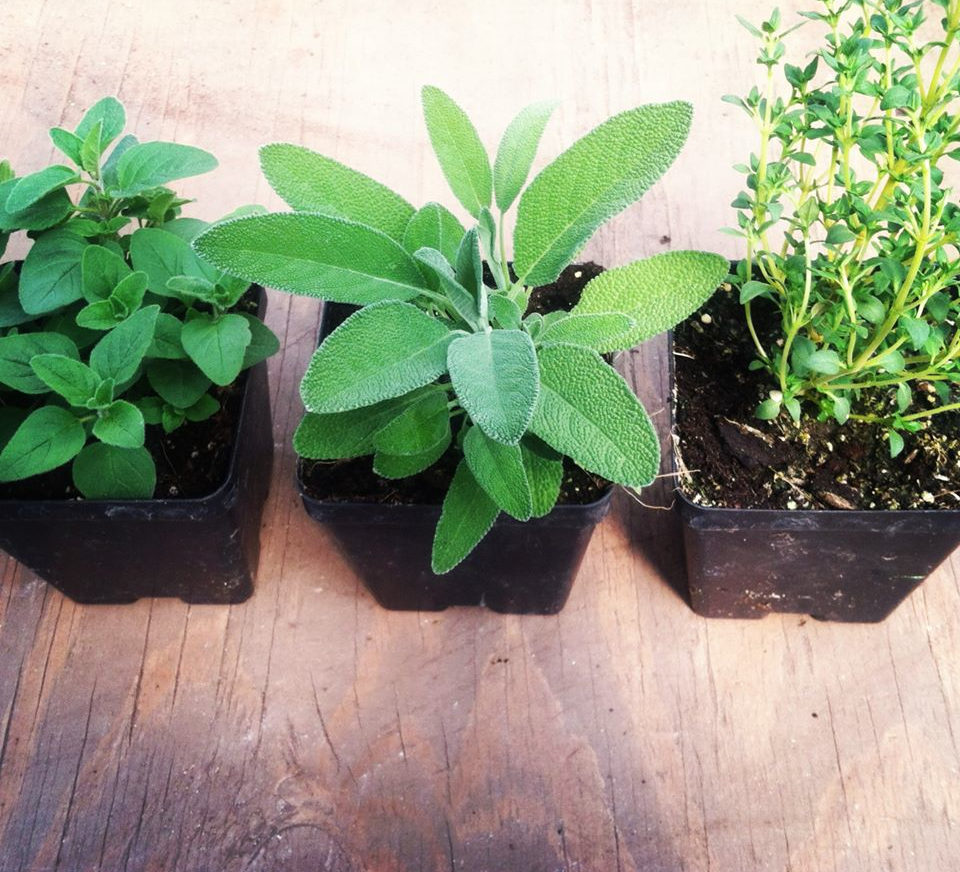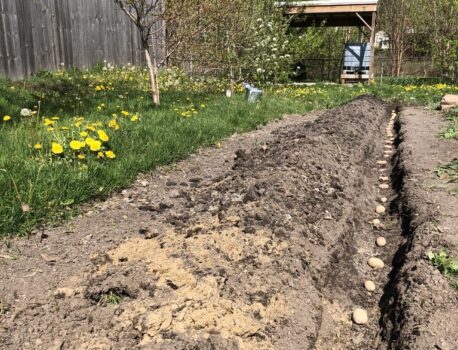Potatoes are one of those crops that you can interact with year-round. Typically planted 4-6 weeks before the last frost, they spend 10 to 18 weeks in the ground. If harvested and stored properly, they can last clear through spring until you plant your next crop.
Early, mid, and late season potatoes
Potatoes are typically split into three categories: early, mid, and late season. This is related to the amount of time they spend in the ground until tubers are mature and harvestable. Early season varieties take the least time (75-90 days) while mid and late season require the entire season to grow (95-110 days or 120-135 days, respectively).
How to calculate potato seed needs?
What are referred to as potato “seeds” are not seeds at all but actual potatoes that you put in the ground. (You may remember the experiment you did in grade school where you balanced a potato in water using toothpicks and it grew plants from its eyes.) This is how growing potatoes in the ground works.
The general rule is that you need 1 pound of potato seed for every 10 feet of potato plants you want. However, you’ll need to modify this based on variety and harvest timing.
Most varieties should be planted 12 inches apart. Fingerling varieties or new potatoes can be planted 6-8” apart. New potatoes are harvested early, before the skin begins to set and cure in the ground. Planting them slightly closer together results in higher yields per foot. With fingerling varieties, closer spacing makes for smaller fingerling style potatoes.
I generally plant new potatoes at 6-8” spacing and harvest every other plant, making space for the plants I leave to grow larger for a fall harvest.
What about planting potatoes in buckets, bags, or other containers?
You can use the same rule for calculating potato seed needs if planting in a container instead of a row. If you’re working with 5 gallon buckets, consider planting only 1-2 seeds per bucket. If you have a container that is 2.5 feet wide like the one pictured below, you can plant 4 seeds total around the edges of the container.
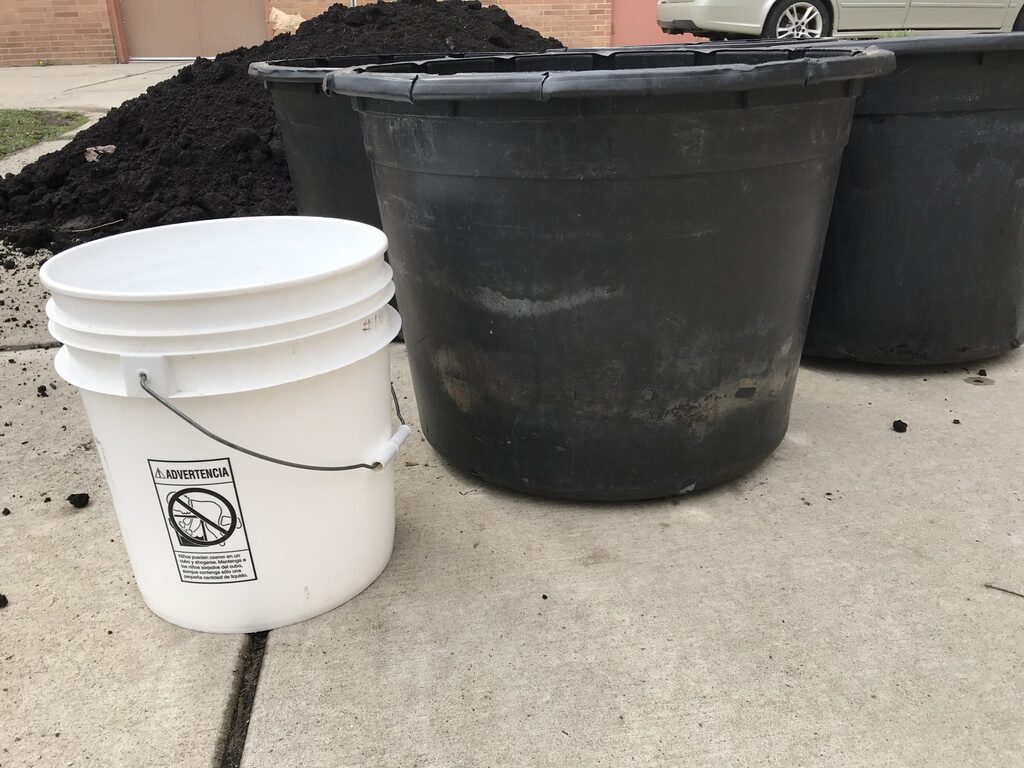

How late can I plant potatoes?
This depends a bit on your climate. Potatoes grow best with temperate weather between 45 and 80 degrees F. I aim to plant April 15 to May 15, depending on how wet the ground is (mid-Michigan is hardiness zone 5b). If you’re growing late season varieties, you’ll need to make sure they get in the ground early enough to mature before cold weather hits. Early season varieties can be planted later (confusing, right?) I’ve planted them as late as May 15/June 1 and they’ve had plenty of time to mature.
Can I plant my store-bought potatoes?
It’s not recommended to plant store-bought potatoes. Non-organic potatoes often have growth inhibitors sprayed on them to prevent them from sprouting in the store or in your cupboard. If you would like to experiment with growing store-bought potatoes, make sure they’re organic!
What about my own potatoes that I grew the previous year?
You can use your own potatoes as seed for the following year if they are free from disease and well preserved. Store them dirty in a dark, dry, and cool place (35-40 degrees F) to keeping them from shriveling. Farmers typically purchase seed potatoes that have been sized appropriately for optimal growth (the size of a chicken egg with 3-4 eyes per tuber is best).
Prepping potatoes for planting
Cutting and curing potatoes
You may end up with oversized seed potatoes that look more fit for playing baseball than planting. For example I ordered 2.5lbs of Yukon Gold seed, planning for 25-30 row feet once planted. However, I only received about 15 potatoes and most potatoes were fist-sized or larger. By cutting most of these pieces in half I was able to nearly double my crop.

Most companies will grade potatoes based on size. If you want to pay less for ungraded seed or if you’re growing from your own saved seed, larger potatoes may be all you have available come planting time. In this scenario you can cut and cure your potatoes.
Potatoes do best in well-drained soil. If you have very heavy clay soil, cutting your potatoes to end up with more seeds can be dicey (pardon the pun). When you cut any plant you are exposing it to potential pathogens – add in cold temperatures and moisture and you have a recipe for rot.
If you have less than ideal soil for potatoes but must cut your potato seeds, cure them for 2-3 days prior to planting or consider applying a sulfur powder to the cut edge before putting them in the ground.
- Make sure you’re using a clean knife when cutting.
- Leave your cut potato seed in a warm environment (70° F) with diffuse lighting, either in a greenhouse with some shade or near a window out of direct light in your house.
- In 2-3 days, a dark callous will form and your potatoes will be ready to plant.
How many eyes should my potato seed have?
The eyes of potatoes is where plant growth begins. You’ll want to consider this if cutting your seed – make sure to cut in such a way that each piece has 3-4 eyes.

Greensprouting or “chitting” potatoes
Many farmers and gardeners swear by greensprouting/pre-sprouting (also known as “chitting”) their potatoes before planting. This is done by exposing potatoes to warmer temperatures to break their dormancy and exposing them to heavily filtered light to encourage sprouting.
If you have a small greenhouse, sunroom, or warm space near a window you can greensprout your potatoes to give them a headstart before planting. Place them in a crate or something that is well aerated, spacing them evenly apart without touching if possible.
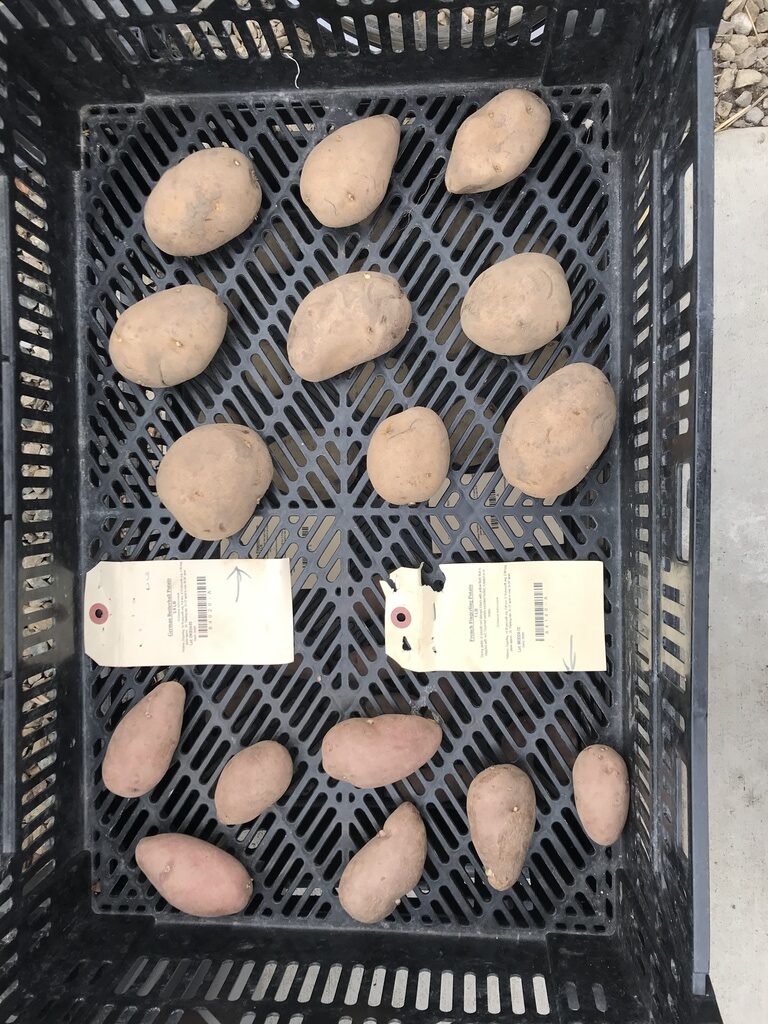
Make sure they are out of direct sunlight, by stacking crates on top of one another or leaving them near a window in your home, ideally at around 70° F.
Leave them to sprout for 3-6 weeks. (If possible, start your greensprouting at the end of March/beginning of April so that your seeds are ready to go once the soil warms.) While this is not necessary it can result in larger yields. It is also recommended for heavy clay soils.
How to plant potatoes
Potatoes prefer full sun so select a nice sunny area if possible. Light, well-drained soil is best –I’ve had moderate success growing potatoes in very heavy clay soil. Prolonged periods of cold wet weather can cause potatoes to rot. If this describes your soil in the spring, consider growing potatoes in a separate container, in a raised bed or delaying your planting date until soil temperatures increase.
Step 1 – Dig a furrow that is 9-12” deep (or the depth of your shovel head).
Step 2 – Plant at appropriate spacing
- Between row: 2-4 feet
- In row: 6-8 inches for new potatoes or fingerling varieties; 12 inches for all others
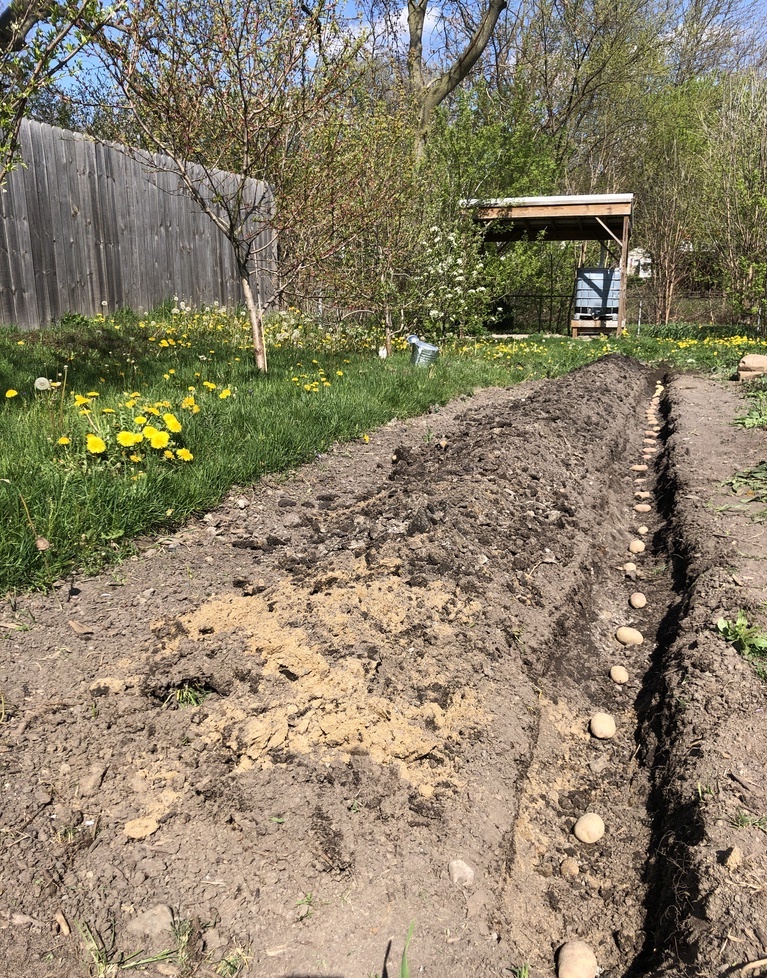
Step 3 – Cover minimally, ideally with some compost, about 2-4”
Step 4 – Water. It’s best to plant into slightly damp soil. Water potato babies within 4 days of planting
**Potato seed is unlike other seeds in that it does not need consistent added moisture to grow. After initial watering wait about two weeks or until plants have started growing before watering again, especially if you are working in heavy soil
Step 5 – Continue to cover as the plants grow. Burry the stems of the potatoes as the plants grow taller until your furrow is filled, about 3-4 inches each time leaving just the tops exposed.
Step 6 – Hill potatoes for increased yields.
Potatoes are adventitious rooting plants. They have tiny hairs on their stems which are actually root initials. If covered with soil, these little hairs have the potential to grow into roots and to form potato tubers (the part that we eat). Keep piling soil around the stems until plants are 4-6 weeks old.
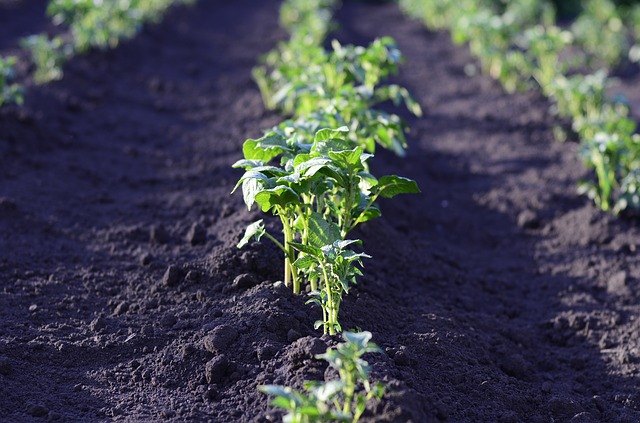
How much water do potatoes need?
Potatoes are like most other plants and require about one inch of water per week, including rain water. Potatoes do best in well-drained soils so if you have heavy soils, make sure not to overwater.
Did you know that potatoes can store for up to 8 months under the right conditions?
Here’s to hoping you can enjoy your potatoes year-round!

